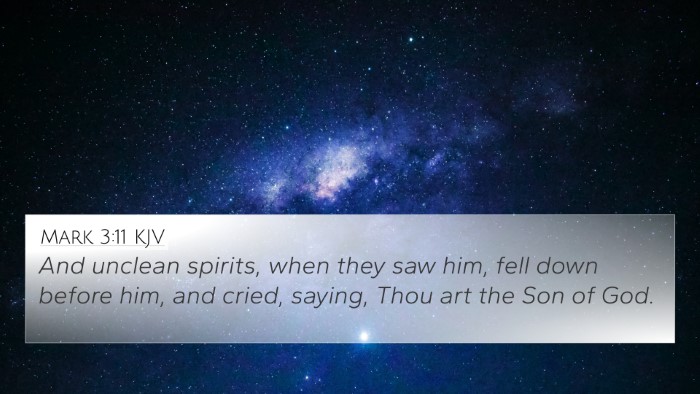Understanding Luke 4:35
Luke 4:35 states: "But Jesus rebuked him, saying, 'Be quiet, and come out of him!' And when the demon had thrown him down in their midst, it came out of him and did not hurt him." This powerful verse occurs during Jesus' ministry in Capernaum, where He demonstrates authority over unclean spirits.
Verse Analysis
The events surrounding Luke 4:35 reveal key aspects of Jesus' character and mission. Here we will summarize insights from prominent public domain commentaries.
Matthew Henry's Commentary
Henry highlights that Jesus commanded the demons with authority, emphasizing His position as the Son of God. The phrase "Be quiet" shows His control over not only the physical realm but also the spiritual. The utterance signifies that evil spirits cannot withstand the power of His word.
Albert Barnes' Notes
Barnes focuses on the uniqueness of Jesus’ interaction with demons. Unlike the exorcisms performed by the Jewish religious leaders of the time, which often included elaborate rituals, Jesus commands the demon directly. This direct encounter illustrates His divine authority, signifying that His teachings are not just words but carry inherent power.
Adam Clarke's Commentary
Clarke provides insights on the reaction of the crowd and the impact of Jesus's authority on the public. The release of the demon-possessed man serves as a testimony to Jesus’ mission of healing and liberation from spiritual oppression. It fulfills the prophetic declarations of the Old Testament regarding the coming of the Messiah.
Thematic Connections in Biblical Texts
The events surrounding this verse also contribute to broader themes within Scripture, illustrating the interaction between Jesus' ministry and prophetic fulfillments. Below are key connections between this verse and other Biblical texts, enhancing our understanding of spiritual authority and Jesus' mission.
- Mark 1:25-26: "But Jesus rebuked him, saying, 'Be silent, and come out of him!' And the unclean spirit, convulsing him and crying out with a loud voice, came out of him." This parallel shows the consistency in Jesus' authority over evil spirits.
- Matthew 8:16: "That evening they brought to him many who were oppressed by demons. And he cast out the spirits with a word and healed all who were sick." Similar to Luke 4:35, this verse highlights Jesus' power over sickness and demonic forces.
- Luke 8:27-29: The account of the Gerasene demoniac demonstrates Jesus' authority over a greater number of demons, showcasing His ability to overcome any force of evil.
- John 10:18: "No one takes it from me, but I lay it down of my own accord." Jesus affirms His sovereign power in the face of evil and death, paralleling His command over demonic possession in Luke 4.
- 1 John 3:8: "The reason the Son of God appeared was to destroy the works of the devil." This verse encapsulates the essence of Jesus' ministry as demonstrated in Luke 4:35, where He actively confronts and dispossesses demons.
- Acts 19:15: "But the evil spirit answered them, 'Jesus I know, and Paul I recognize, but who are you?'" This juxtaposition illustrates that even spiritual entities recognize Jesus’ authority, making explicit His unique power.
- Colossians 2:15: "He disarmed the rulers and authorities and put them to open shame, by triumphing over them in him." This provides the theological underpinning for events such as the one in Luke 4:35, reinforcing the notion of Christ’s victory over such powers.
Comparative Analysis
This verse provides rich material for a comparative Bible verse analysis, especially regarding the authority and power exhibited by Jesus. These connections can be emphasized through cross-referencing Biblical texts. Comparing scriptural passages can expose deeper layers of understanding and illustrate how various writers portray the authority of Jesus.
For example, one can analyze the different contexts in which Jesus encounters demons in the Gospels. Each instance provides unique facets to understanding His mission and the broader theme of spiritual warfare prevalent in Scripture. Such comparative studies amplify the message of redemption that is integral to the Gospel narrative.
Tools for Bible Cross-Referencing
To explore these connections further, various tools are available for Biblical cross-referencing:
- Bible Concordance: Instruments for locating specific words and their occurrences throughout Scripture.
- Bible Cross-Reference Guide: Resources that group similar scriptures, allowing readers to explore themes efficiently.
- Cross-Reference Bible Study: A method encouraging readers to explore related verses to uncover deeper meanings.
- Bible Reference Resources: Collections of verses grouped by theme, aiding in studying specific doctrinal points.
- Bible Chain References: Systems that connect verses in a 'chain' corresponding to themes or events.
Conclusion
Luke 4:35 not only reveals the authority of Jesus in casting out demons but also serves as a reliable verse for cross-referencing to better understand the overarching narrative of redemption in Christian theology. By linking and comparing various scriptures, believers can enrich their understanding of the Biblical text and its application in spiritual warfare and the ongoing struggle against evil.
In essence, utilizing comprehensive Bible cross-reference materials helps deepen the understanding of Jesus' mission and the unyielding authority He possesses over all spiritual forces. By exploring these connections, anyone engaging with Scripture can gain insights into the power dynamics depicted in the Bible and how they relate to contemporary spiritual challenges.

















